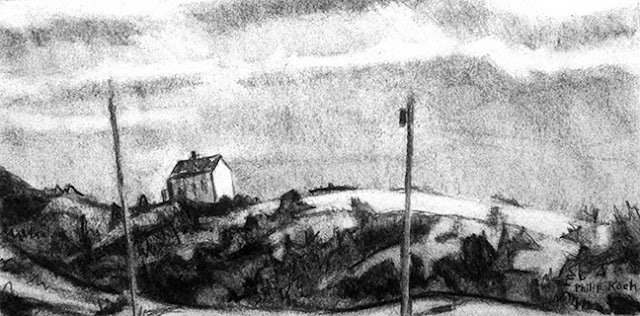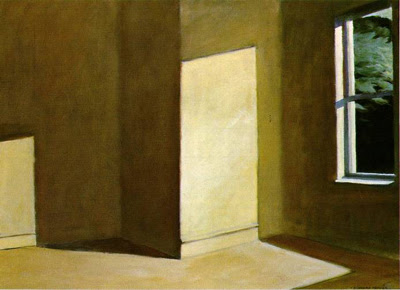My Old Flames
Sometimes you look back at your old heartthrobs. I don't have such an active relationship with them today, but here are two artists who once were a huge help to me finding my way. We have some great memories of our times together...
I've often told the story about how I never intended to become an artist. There was art in my family background- my great grandfather John Wallace was a Scottish landscape painter and his work decorated our living room. My mother's dad John Capstaff was a photographer and developed the first commercially available color film (Kodachrome) back in 1915. And my dad's brother Robert Koch was an art historian who taught at Princeton for many decades (his specialty was the early 16th century painter Joachim Patinir, a transitional figure in later Renaissance painting who was known for leading the way in giving a far larger role to the landscape in his figure paintings).
But I wanted none of that, figuring I was a more "serious" person and would study politics and sociology. That lasted only a few weeks into my first semester at Oberlin College when I felt myself falling into the paintings that were being projected on the screen in my Art History 101 class. Ironically I had only enrolled in that course to get the College's "art or music requirement" out of the way. Dangerous things those required courses...
The short story is I went on to major in studio art, knocked out a pile of abstractions, taught myself how to draw from direct observation, and made some halting progress with a my first group of realist paintings. Then I arrived in grad school, Indiana University's MFA Painting Program. As luck would have it, the campus art museum had some 1st rate 19th century landscape paintings, a kind of art I'd never paid much attention to before. Somehow the ground must have been shifting beneath my feet as suddenly I couldn't get enough of their paintings of rocky shorelines and moody woodlands.
The campus bookstore carried a small pocketbook of the British painter John Constable (1776-1837) that I bought and devoured in worshipful detail. Above is Constable's oil Dedham Vale. I found a bunch of things attractive in his work but nothing as much as its familiarity. When I turned 4 my family moved to a then distant suburb of Rochester, NY, Webster and built a house on the shore of Lake Ontario in a dense forest. It was wildly vivid to a young boy like me. The wind off the lake would usually be vigorously stirring the trees. Most of the time, unless you stepped out into one of the few clearings or went right onto the beach the woods were pretty dark. There were very few other kids around, so I ended up spending lots of time alone playing in the forest. When I came across that book on Constable it looked ever so much like the old neighborhood I'd left behind. I was a goner.
Constable's Dedham Vale has a wonderful drama to it- I get the feeling Constable was wrapping the clouds around the trees at the right like a scarf around a neck.
Constable was also a great teacher to me in showing me how to build up a painting in layers, letting little bits of the colors underneath show through the outer layers. I carefully made several copies of paintings in oil from the book. I was amazed to see how he could get away with starting a tree's interior with a coat of deep burnt sienna reds. On top of that he'd lay in the masses of foliage in greens. To someone who had first learned to paint using acrylics imitating the simple flat shapes of artists like early Frank Stella this seemed a revelation.
As I pushed further into landscape I started looking back to the artists that Constable had turned to. One of his favorites was Jacob van Ruisdael (Dutch 1628-1682). Above is his Landscape with a Windmill. Its placid mood couldn't be more different than the Constable painting above. There's a remarkable conversation Ruisdael sets up between the sky and the land.
It's one of the great ironies of landscape painting- you go outside and the sky and the earth normally seem so far away from each other in color and tone. Yet in the hands of master painters like these two landscapists, somehow the gulf between the ground where we stand and the sky above is bridged. Perhaps unconsciously we all long to be at one with the heavens. It their way, I think their vision of earth and sky tied together as one is something we find so deeply satisfying.
One of Ruisdael's most impressive moves in this painting is the variety of silhouettes he places up against the sky- one of the trees being a network of little openings through which any sparrow could sail, and the other a somberly solid and majestic tower of the windmill. Don't the windmill's blades have great shapes- they look like they could be feathers that have fallen from some gigantic bird.
As active as the right hand side of Ruisdael's painting is, look at how he turns the volume down at the left hand side, letting us drop our guard and meander through some reassuring gentle pasture. He could install drama but he knew when to balance it off against some quiet areas.
I don't think it's possible to paint just like Ruisdael or Constable today. Each generation perceives being alive in slightly differing ways. And each generation has a need for new artists to take up the challenge to find ways to describe the particular feel of its time. Part of that is to show us what the world looks like to us now. One of my greatest delights is to build my own place on that long line of landscape painters stretching back to Constable, and to Ruisdael, and beyond. It's one heck of a good story.
P.S. I am happy to report that after it taking an unscheduled vacation for a day this week, my website is back up and running using a new web host. It is being completely re-done with new information and images. I am glad I have a good assistant helping me do it. More new content is being added daily.
Remember the website has a new address: philipkoch.org




